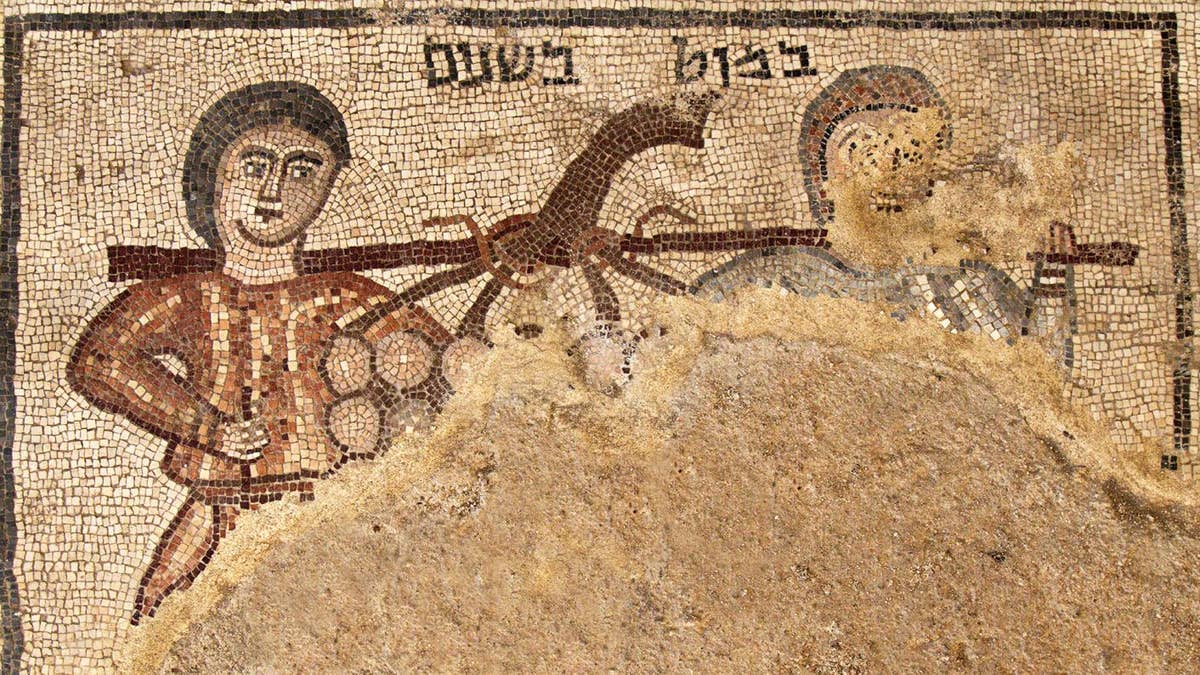
The panel depicting the biblical spies (Jim Haberman)
Researchers have uncovered a stunning mosaic depicting a biblical scene at the site of an ancient synagogue in Northern Israel.
The mosaic, which is the latest to be discovered at the fifth-century synagogue in Huqoq, depicts a scene from Numbers 13:23. Labeled "a pole between two," the panel shows two spies sent by Moses to explore the biblical land of Canaan. The spies are shown carrying a pole with a cluster of grapes, which they took to Moses as evidence of Canaan’s abundance.
Another recently discovered panel, which references Isaiah 11:6, includes the inscription "a small child shall lead them," and depicts a youth leading an animal on a rope.
ANCIENT SYNAGOGUE MOSAIC DEPICTS BLOODY JEWISH LEGEND
The first mosaics at the site were discovered in 2012. Experts say that the wealth of mosaics show that Jewish life in the surrounding village flourished during Christian rule in the fifth century A.D. This challenges a widely held view that Jewish settlement in the area declined during that period.
“The selection of these scenes to decorate the synagogue sheds light on Judaism in late antiquity – a period when Christianity was spreading and Jewish communities in the Roman Empire were living under Christian rule,” Excavation Director and University of North Carolina at Chapel Hill Professor Jodi Magness told Fox News, via email.
Magness noted that the floor of the synagogue is paved with mosaic panels, most of which depict biblical stories. “Nearly all of the biblical stories found so far have no parallels in any other ancient synagogue -this is true also of the panels discovered this summer,” she said.
RARE MOSAIC DEPICTING NOAH'S ARK DISCOVERED IN ANCIENT SYNAGOGUE
Previous mosaics discovered at Huqoq include depictions of Samson, Noah’s Ark and Jonah being swallowed by three successive fish.
There is also ongoing debate about whether a mosaic uncovered in 2016 portrays Alexander the Great.
The latest dig, which is the eighth at the site, further exposed the remains of 1,600-year-old columns covered in colorful, painted plaster. “This is significant because painted plaster decorating walls or columns in ancient buildings was not uncommon in antiquity, but is rarely preserved,” explained Magness. “Only a couple of other ancient synagogues in Israel have yielded remains of painted plaster on the scale of ours. This helps us understand how richly decorated the building was – not just the floors, but the walls and columns as well.”
RARE DISCOVERY: ANCIENT SYNAGOGUE MOSAIC MAY DEPICT ALEXANDER THE GREAT
In order to conserve the mosaics they have been removed from the site and the excavated area has been “backfilled” with soil to protect the remains of the ancient synagogue until next summer’s dig.
“We will continue for at least four more years until we have completed the excavation of the synagogue, and then the excavations will end and we will work on publication,” Magness told Fox News.
The Huqoq Excavation Project involves experts from a host of universities, including Baylor University, Brigham Young University and the University of Toronto. Magness has been working with Shua Kisilevitz of the Israel Antiquities Authority and Tel Aviv University on the excavations every summer.
DEAD SEA SCROLLS DISCOVERY: TECH REVEALS HIDDEN SCRIPT
There have been a number of fascinating finds in the region in recent years. Archaeologists, for example, recently unearthed an extremely rare ancient clay amulet with a blessing in Arabic.
Earlier this year experts also announced the discovery of a site that may offer fresh insight into the ancient biblical kingdom of David and Solomon. In another project a trove of bronze coins, the last remnants of an ancient Jewish revolt against the Roman Empire, were recently discovered near the Temple Mount in Jerusalem.
In February, archaeologists announced the discovery of a clay seal mark that may bear the signature of the biblical Prophet Isaiah.
MYSTERIOUS POOL AND FOUNTAIN DISCOVERED AT ANCIENT CHRISTIAN SITE IN ISRAEL
Last November, new evidence dated Christ’s tomb in Jerusalem’s Church of the Holy Sepulchre to the Roman era, matching historical records.
Other finds include the skeleton of a pregnant woman, dating back 3,200 years, in Israel’s Timna Valley, at a place once called King Solomon’s Mines.
At the site of an ancient city on the West Bank, archaeologists are also hunting for evidence of the tabernacle that once housed the Ark of the Covenant.
Some experts also believe they have found the lost Roman city of Julias, formerly the village of Bethsaida, which was the home of Jesus' apostles Peter, Andrew and Philip.
Follow James Rogers on Twitter @jamesjrogers
